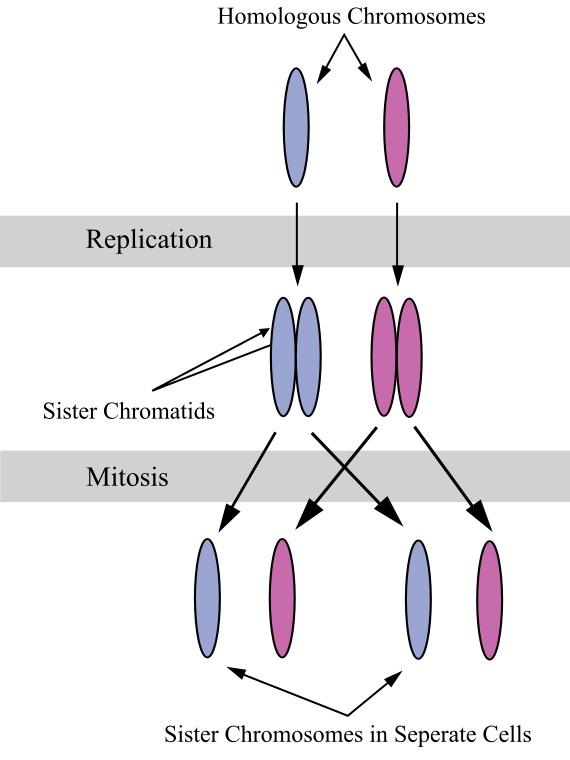Difference Between Homologous Chromosomes and Sister Chromatids
Chromosomes are self-reproducing permanent structures of the cell nucleus in eukaryotes. They are the material carriers of the hereditary information. Each species has a specific number of chromosomes. Like many animal and plant species, humans are diploid organisms (2n), which means that the chromosomes are grouped in pairs, called homologous. Chromosomes can be seen with an optical microscope during cell division (metaphase).
During cell division, each metaphase chromosome consists of two parts, called sister chromatids. They are a result of duplication of DNA through the cell division process and thus are completely identical.
What is Homologous Chromosomes?
Diploid cells have two copies of each chromosome, known as homologous chromosomes. The two homologous chromosomes are similar in size, shape, and centromere location. The type of genetic information they carry is also similar. In sexually reproducing species, one of the homologous chromosomes comes from the father’s gametes and the other one – from the mother’s gametes. In humans, each somatic cell has 23 pairs of homologous chromosomes, giving a total of 46 chromosomes. Two of them are the sex chromosomes that determine the sex of a person.
For most of the cell’s life, each chromosome is composed of one DNA molecule. In preparation for cell division, the DNA molecule doubles, and forms two sister chromatids. They form at a point in the cycle and the development of the cell – the S subphase of the interphase. For the rest of the time, the chromosome is a single strand with a specific pinch (narrower part), called a centromere. The centromere splits the chromosome into two arms. Peripherally, a structure called a kinetochore is built around the centromere. It serves to attach microtubules to the division of chromatids in cell division.
Chromosomes with equal arms are called metacentric. If one of the arms is visibly longer than the other, the chromosome is called submetacentric. There are also the so-called acrocentric chromosomes, in which there is a secondary pinching, which separates a small section called a satellite. Such chromosomes in human cells are 13, 14, 15, 21 and 22.
What is Sister Chromatids?
When the cell prepares to divide, it has to make a copy of each of its chromosomes. The two copies of one chromosome are called sister chromatids. The sister chromatids are identical and are linked to each other by proteins called cohesins. The sister chromatids are connected in the so-called centromere, a part of the DNA that is important for their separation in the further stages of cell division. Through it, the chromosomes attach to the spindle apparatus – a cytoskeletal structure in the eukaryotic cells, which forms during the cell division process. Its aim is to separate sister chromatids between daughter cells.
While the sister chromatids are linked in the centromere, they are still considered to be a part of a single chromosome. During cell division, they separate from each other. Than each chromatid is distinguished as a separate chromosome for the respective daughter cell.
Difference Between Homologous Chromosomes and Sister Chromatids
Definition
Homologous Chromosomes: Homologous chromosomes are a couple of one maternal and one paternal chromosome, paired up during fertilization in a diploid cell.
Sister Chromatids: The two copies of one chromosome, linked together in the centromere are called sister chromatids.
Origin
Homologous Chromosomes: In sexually reproducing species, one of the homologous chromosomes comes from the father’s gametes and the other one – from the mother’s gametes.
Sister Chromatids: In sexually reproducing species, each sister chromatid comes from either the father’s or mother’s gametes.
Similarity
Homologous Chromosomes: The homologous chromosomes are similar in size, shape, and centromere location. The type of genetic information they carry is also similar.
Sister Chromatids: Sister chromatids are identical.
Structure
Homologous Chromosomes: For most of the cell’s life, each chromosome is composed of one DNA molecule. In preparation for cell division, the DNA molecule doubles.
Sister Chromatids: Each sister chromatid is composed of one DNA molecule.
Connection
Homologous Chromosomes: The homologous chromosomes are not connected with each other.
Sister Chromatids: The sister chromatids are linked to each other by proteins called cohesions, via the centromere.
Difference between Homologous Chromosomes and Sister Chromatids
Summary:
- Chromosomes are self-reproducing permanent structures of the cell nucleus in eukaryotes, material carriers of the hereditary information.
- Homologous chromosomes are a couple of one maternal and one paternal chromosome, paired up during fertilization in a diploid cell.
- Two copies of one chromosome, linked together in the centromere are called sister chromatids.
- One of the homologous chromosomes comes from the father’s gametes and one – from the mother’s gametes. Each sister chromatid comes from either the father’s or mother’s gametes.
- The homologous chromosomes are similar in size, shape, and centromere location. The type of genetic information they carry is also similar. Sister chromatids are identical.
- For most of the cell’s life, each chromosome is composed of one DNA molecule. In preparation for cell division, the DNA molecule doubles. Each sister chromatid is composed of one DNA molecule.
- The homologous chromosomes are not connected with each other. The sister chromatids are linked to each other by proteins called cohesions, via the centromere.
- Difference Between Gallstones and Cholecystitis - September 5, 2021
- Difference Between Constipation and Cramping - August 4, 2021
- Difference Between Whole Genome Sequencing and Microarray - May 6, 2021
Search DifferenceBetween.net :
Leave a Response
References :
[0]Image credit: https://commons.wikimedia.org/wiki/File:Chromosomes_during_mitosis.svg
[1]Image credit: https://commons.wikimedia.org/wiki/File:HR_in_meiosis.svg
[2]Ayala, J. and J. Kiger. Modern Genetics. San Francisco: Benjamin-Cummings Publishing Company. 1989. Print.
[3]Klug, W. and M. Cummings. Concepts of Genetics (6th Edition). 1999. Print.
[4]Stubs, M. and N. Suleyman. Cell biology and genetics. China: Elsevier. 2013. Print.



